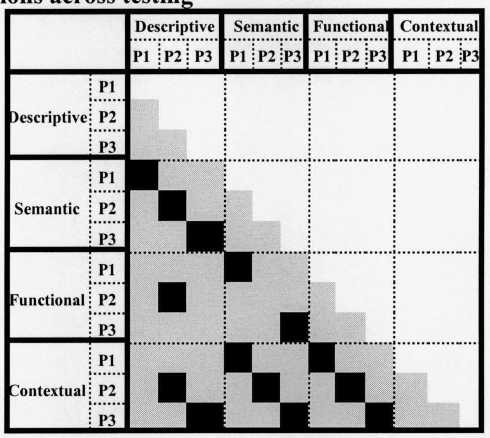(Wilcoxon: Z=7.6, p<.0000 and Z=6.3, p<.0000 respectively). Diagram 7.4 gives a graphical
representation of the previous significant differences between the properties.
Diagram 7.4 Significant group differences among the properties mentioned in the
definit>nnβ «ernes
nsfinσ

Analysis of the Descriptive properties
Is there a differential impact of the type of exposure to new lexical items that the children
receive on the provision of descriptive properties?
No significant differences were found for post test 1. Significant differences were found for
post test 2 (Kruskall-Wallis 1 Way-Anova: X2 = 31.2, df= 2 p<.0005) and post test 3 (X2 =
26.6, df= 4, p<.0000). During post test 2, “descriptive'' properties were used significantly
more by the Definition group than the Ostensive definition (Wilcoxon: Z = 4.1, p<.0005) and
the Lexical contrast group (Wilcoxon: Z =4.4, p<.0005). During post test 3, “descriptive"
properties were used significantly more by the Definition than the Control (Wilcoxon: Z=3.5,
p<.0005) the Phonological control group (Wilcoxon: Z=4.3, p<.0000) and the Ostensive
definition group (Wilcoxon: Z=3.5, p<.0005). In addition, descriptive properties were used
significantly more by the Lexical contrast than the Control (Wilcoxon: Z=3.5, p<.0005) and
Phonological control group (Wilcoxon: Z= 4.3, p<.0000).
215
More intriguing information
1. Optimal Tax Policy when Firms are Internationally Mobile2. RETAIL SALES: DO THEY MEAN REDUCED EXPENDITURES? GERMAN GROCERY EVIDENCE
3. Robust Econometrics
4. Altruism with Social Roots: An Emerging Literature
5. Life is an Adventure! An agent-based reconciliation of narrative and scientific worldviews
6. Evidence on the Determinants of Foreign Direct Investment: The Case of Three European Regions
7. The Social Context as a Determinant of Teacher Motivational Strategies in Physical Education
8. THE CO-EVOLUTION OF MATTER AND CONSCIOUSNESS1
9. Wirkung einer Feiertagsbereinigung des Länderfinanzausgleichs: eine empirische Analyse des deutschen Finanzausgleichs
10. Innovation in commercialization of pelagic fish: the example of "Srdela Snack" Franchise